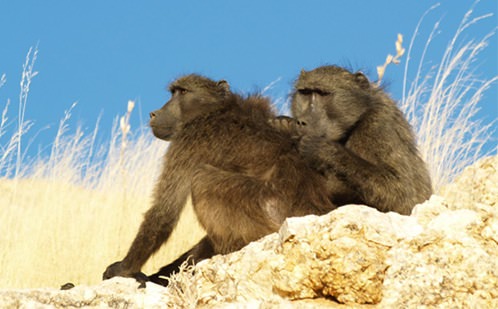Baboons groom other, more powerful members of their groups early in the morning so that they will be favoured through the rest of the day, a study has found.
Grooming between individuals in a group of baboons is not practiced without ulterior motives. To be groomed has hygienic benefits and is stress relieving for the individual, while grooming another individual can provide access to infants, mating opportunities and high quality food by means of tolerance at a patch. This can be used in a strategic manner by trading grooming for one of these commodities as stated by the biological market theory. A new study from Department of Biology, University of Copenhagen and Zoological Society of London shows that such social strategies in chacma baboons vary across the day in a manner where subordinate individuals will gain most from their grooming activities.
“We investigated whether diurnal changes in the value of one commodity, tolerance at shared food patches, lead to diurnal patterns of affiliative interaction, namely grooming. As predicted, we found that, in wild chacma baboons, subordinates were more likely to groom the more dominant individuals earlier in the day, when most foraging activities still lay ahead and the need for tolerance at shared feeding sites was greatest”, says MSc biologist Claudia Sick, Section for Ecology and Evolution, Department of Biology, University of Copenhagen in affiliation with Zoological Society of London.
This study shows that social strategies of baboons can vary across the day and the findings suggest that group-living animals optimize certain elements of their social strategies over short periods of time. It is commonly known that strong social bonds over several years can make an important contribution to the fitness of individuals in animal groups. Therefore one could expect individuals to invest primarily in such long-term relationships. However, studies have shown that relationships also vary over months and weeks in accordance with a biological market. This study’s new findings indicate that social strategies may be even more flexible and optimized over even shorter periods that previously appreciated.
These new insights highlight the importance of understanding the full range of time periods over which social strategies may be optimized. Such knowledge is crucial when studying the social behaviour and strategies of group-living animals.
Agencies/Canadajournal
 Canada Journal – News of the World Articles and videos to bring you the biggest Canadian news stories from across the country every day
Canada Journal – News of the World Articles and videos to bring you the biggest Canadian news stories from across the country every day



